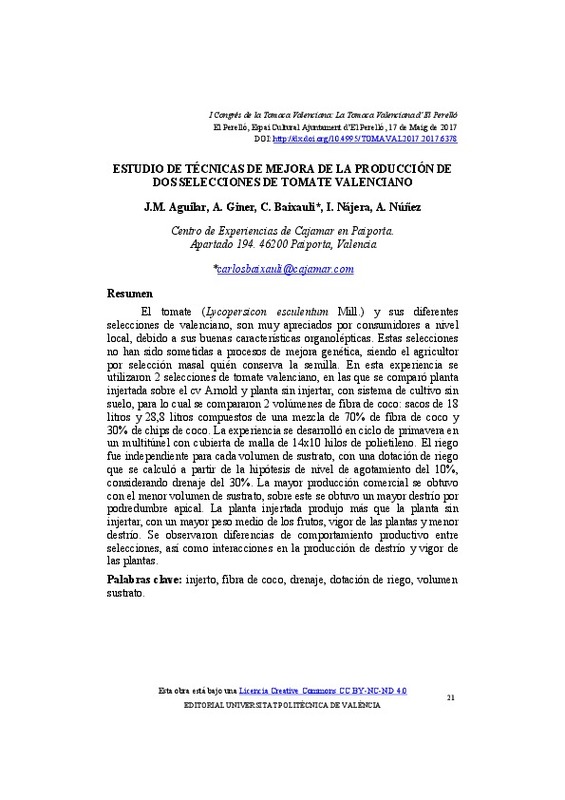|
Resumen:
|
[ES] El tomate (Lycopersicon esculentum Mill.) y sus diferentes selecciones de valenciano, son muy apreciados por consumidores a nivel local, debido a sus buenas características organolépticas. Estas selecciones no han ...[+]
[ES] El tomate (Lycopersicon esculentum Mill.) y sus diferentes selecciones de valenciano, son muy apreciados por consumidores a nivel local, debido a sus buenas características organolépticas. Estas selecciones no han sido sometidas a procesos de mejora genética, siendo el agricultor por selección masal quién conserva la semilla. En esta experiencia se utilizaron 2 selecciones de tomate valenciano, en las que se comparó planta injertada sobre el cv Arnold y planta sin injertar, con sistema de cultivo sin suelo, para lo cual se compararon 2 volúmenes de fibra de coco: sacos de 18 y 28,8 l compuestos de una mezcla de 70% de fibra de coco y 30% de chips de coco. La experiencia se desarrolló en ciclo de primavera en un multitúnel con cubierta de malla de 14x10 hilos de polietileno. El riego fue independiente para cada volumen de sustrato, con una dotación de riego que se calculó a partir de la hipótesis de nivel de agotamiento del 10%, considerando drenaje del 30%. La mayor producción comercial se obtuvo con el menor volumen de sustrato, sobre este se obtuvo un mayor destrío por podredumbre apical. La planta injertada produjo más que la planta sin injertar, con un mayor peso medio de los frutos, vigor de las plantas y menor destrío. Se observaron diferencias de comportamiento productivo entre selecciones, así como interacciones en la producción de destrío y vigor de las plantas.
[-]
[EN] The tomato Valenciano is very appreciated by consumers, especially
in the province of Valencia, due to its good organoleptic characteristics.
These cultivars do not have resistance to pests and diseases. The ...[+]
[EN] The tomato Valenciano is very appreciated by consumers, especially
in the province of Valencia, due to its good organoleptic characteristics.
These cultivars do not have resistance to pests and diseases. The farmer
himself, after a mass selection, is who mainly develop the tasks of
conservation and reproduction of the seeds. Two cultivars of tomato
valenciano were used for the development of the experience and they were
analyzed different crop management. On the one hand it was studied the
behavior of the plant that it was grafted on the cv Arnold and it was
compared with a control without grafting. On the other hand the experiment
was carried out in a soilless system and they were compared 2 coconut fiber
volumes: on the basis of 18 liters and 28.8 liters sacks, both of them
composed of a mixture of 70% of coconut fiber and 30% of coconut chips.
The experience was developed in the spring cycle in a multitunnel mesh
cover of 14x10 threads of polyethylene. Irrigation was independent for each
substrate volume. The watering regime was determined on the basis of the
hypothesis of 10-30% depletion level from the drainage. The largest
commercial production was obtained with the lower volume sack and there
had also been an increase amount of non-commercial yield, as a result of
fruits affected by blossom end rot. Grafted plants achieved a greater
commercial production that plants without grafting. Moreover, those ones
grafted reached also a higher average weight of the fruits and lower noncommercial production, mainly due to the elevated incidence of blossom
end rot in plants without grafting. Grafted plants were more vigorous than
those ones non- grafted. There were detected differences between cultivars
for productive performance, as well as interactions for non-commercial
production and plant vigor.
[-]
|








